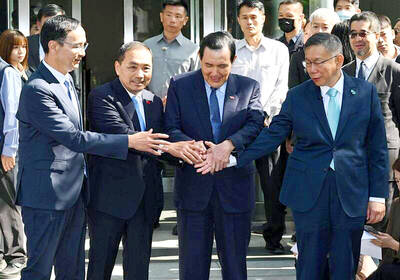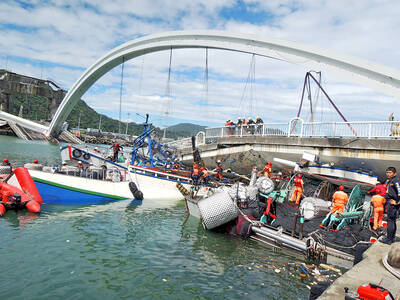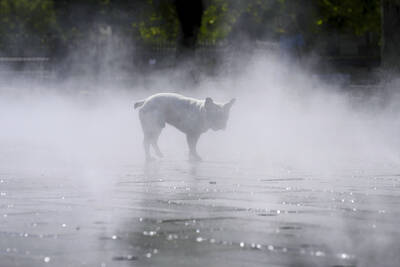At its best, Vietnamese food is fresh and delicate, with raw and cooked ingredients meeting at the table -- like petals of rare beef cooking in a bowl of pho -- or even in the mouth, as when a crunchy slice of spring roll is wrapped in lettuce with cucumber and basil.
A minute's walk from the MRT's Wanfang Hospital station, Saigon, Saigon delivers a long and authentic menu of Vietnamese favorites. The prices too are refreshing, with substantial dishes starting from NT$80 and plenty of side dishes, salads and desserts all under NT$100. Diners would be hard-pressed to spend more than NT$500 for a lavish lunch for two. Also, the set lunch is a special bargain, with strong Vietnamese coffee, choice of beef or wonton soup, and barbecued pork with rice noodles and vegetables for only NT$150.

PHOTO COURTESY OF SAIGON SAIGON
A favorite snack is ban xeo, a pancake of rice flour and coconut milk, stuffed with vegetables, sliced shrimp and pork for NT$80. It's lacy and light in this restaurant's version, so it's better to dip bites in the sauce so it doesn't dissolve into mush on the plate.
The spring rolls (NT$60) are unusual, spongy and crumbly with meat rather than the usual chewy stuffing of clear noodles and shredded carrots. They're served with lettuce, cucumbers and rice noodles to be wrapped together and dipped in sauce. More unusual are the "fresh warm rolls" stuffed with pork for NT$60 (or shrimp for NT$70), slippery parcels of rice noodles with oily but savory chopped pork.
The raw "salad rolls" for NT$55 are a healthier item, though the rice-paper skin was slightly tough. A sinus-clearing green papaya salad for NT$80 and chicken salad for NT$50 and NT$80 were both excellent.
These items were only a sampling of the first two menu pages, followed by pages of rice, noodles and soups. All the soups I tried were great except for the bun rieu or seafood with vermicelli, a strangely crimson broth of too-soft noodles in a bland broth with small fishcake balls for NT$80. The pho (beef soup with rice noodles) was fragrant with cinnamon and ranged from NT$80 to NT$150. Fresh coconut juice is NT$60, and there's salty lemon drink and Vietnamese beer for traditionalists. Desserts are various fruits (NT$45) or mung beans ($35) served over rice with coconut milk.
Owner Ted Yeh says his place is offers authentic Vietnamese food because it's a family enterprise. A trip to the city's south side is a lot cheaper than a ticket to Ho Chi Min City, and Saigon, Saigon delivers its exotica in unpretentious comfort.

Has the Taiwan People’s Party (TPP) changed under the leadership of Huang Kuo-chang (黃國昌)? In tone and messaging, it obviously has, but this is largely driven by events over the past year. How much is surface noise, and how much is substance? How differently party founder Ko Wen-je (柯文哲) would have handled these events is impossible to determine because the biggest event was Ko’s own arrest on multiple corruption charges and being jailed incommunicado. To understand the similarities and differences that may be evolving in the Huang era, we must first understand Ko’s TPP. ELECTORAL STRATEGY The party’s strategy under Ko was

It’s Aug. 8, Father’s Day in Taiwan. I asked a Chinese chatbot a simple question: “How is Father’s Day celebrated in Taiwan and China?” The answer was as ideological as it was unexpected. The AI said Taiwan is “a region” (地區) and “a province of China” (中國的省份). It then adopted the collective pronoun “we” to praise the holiday in the voice of the “Chinese government,” saying Father’s Day aligns with “core socialist values” of the “Chinese nation.” The chatbot was DeepSeek, the fastest growing app ever to reach 100 million users (in seven days!) and one of the world’s most advanced and

Before the recall election drowned out other news, CNN last month became the latest in a long line of media organs to report on abuses of migrant workers in Taiwan’s fishing fleet. After a brief flare of interest, the news media moved on. The migrant worker issues, however, did not. CNN’s stinging title, “Taiwan is held up as a bastion of liberal values. But migrant workers report abuse, injury and death in its fishing industry,” was widely quoted, including by the Fisheries Agency in its response. It obviously hurt. The Fisheries Agency was not slow to convey a classic government

It turns out many Americans aren’t great at identifying which personal decisions contribute most to climate change. A study recently published by the National Academy of Sciences found that when asked to rank actions, such as swapping a car that uses gasoline for an electric one, carpooling or reducing food waste, participants weren’t very accurate when assessing how much those actions contributed to climate change, which is caused mostly by the release of greenhouse gases that happen when fuels like gasoline, oil and coal are burned. “People over-assign impact to actually pretty low-impact actions such as recycling, and underestimate the actual carbon